人教Pep六年级英语上册知识点总结
人教版PEP六年级英语上册知识点汇总
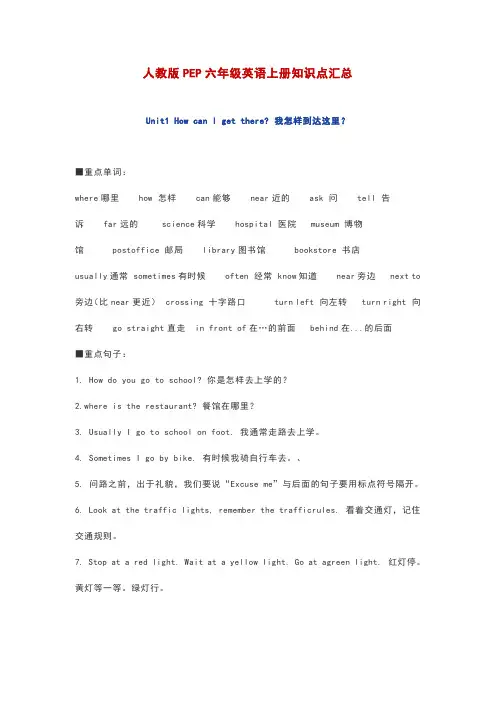
人教版PEP六年级英语上册知识点汇总Unit1 How can I get there? 我怎样到达这里?■重点单词:where哪里 how 怎样 can能够 near近的 ask 问 tell 告诉 far远的science科学 hospital 医院museum 博物馆postoffice 邮局 library图书馆bookstore 书店usually通常 sometimes有时候 often 经常 know知道 near旁边next to 旁边(比near更近)crossing 十字路口turn left 向左转turn right 向右转 go straight直走in front of在…的前面behind在...的后面■重点句子:1. How do you go to school? 你是怎样去上学的?2.where is the restaurant? 餐馆在哪里?3. Usually I go to school on foot. 我通常走路去上学。
4. Sometimes I go by bike. 有时候我骑自行车去。
、5. 问路之前,出于礼貌,我们要说“Excuse me”与后面的句子要用标点符号隔开。
6. Look at the traffic lights, remember the trafficrules. 看着交通灯,记住交通规则。
7. Stop at a red light. Wait at a yellow light. Go at agreen light. 红灯停。
黄灯等一等。
绿灯行。
8. Red means stop, yellow means wait, green means go. 红色的意思是停止,黄色的意思是等待,绿色的意思是通行。
9. How can I get to the park? 我该怎样到达公园呢?10. You can go by the No. 15 bus. 你可以坐15路公交车去。
人教版(PEP)小学英语六年级上册知识点归纳
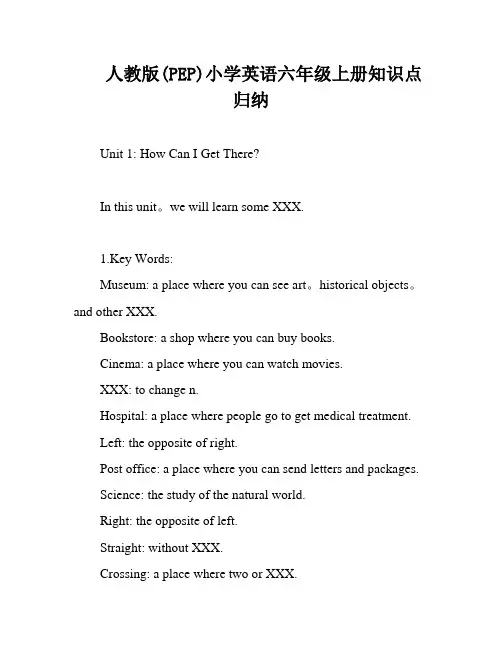
人教版(PEP)小学英语六年级上册知识点归纳Unit 1: How Can I Get There?In this unit。
we will learn some XXX.1.Key Words:Museum: a place where you can see art。
historical objects。
and other XXX.Bookstore: a shop where you can buy books.Cinema: a place where you can watch movies.XXX: to change n.Hospital: a place where people go to get medical treatment.Left: the opposite of right.Post office: a place where you can send letters and packages.Science: the study of the natural world.Right: the opposite of left.Straight: without XXX.Crossing: a place where two or XXX.eful Phrases:Post office: "Where is the post office?"Science museum: "Where is the science museum?"Pet hospital: "Where is the pet hospital?"XXX: "Where is XXX?"XXX: "Where is Beihai Park?"Palace Museum: "Where is the Palace Museum?"Go straight: "Go straight and you will see the bookstore on your left."Turn right/left: "Turn right at the crossing and you will see the hospital on your right."Next to: "The cinema is next to the bookstore."In front of: "The school is in front of the park."Near the park: "XXX is near the park."XXX: "XXX."mon ns:Excuse me: "Excuse me。
人教PEP版六年级英语上册重点知识梳理
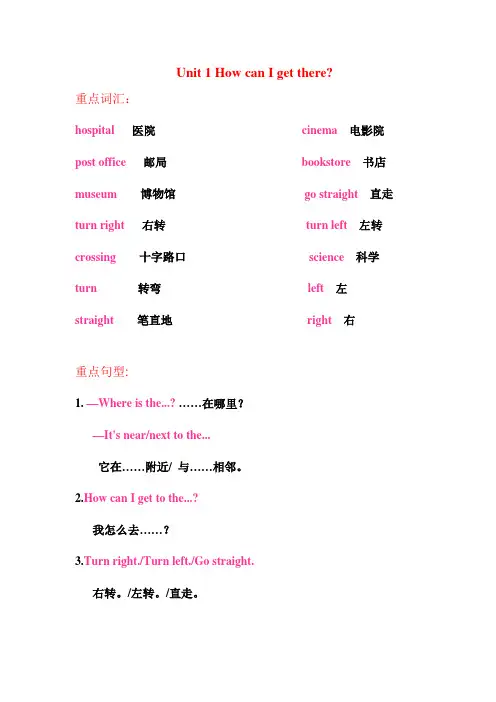
Unit 1 How can I get there?重点词汇:hospital 医院cinema 电影院post office 邮局bookstore 书店museum 博物馆go straight 直走turn right 右转turn left 左转crossing 十字路口science 科学turn 转弯left 左straight 笔直地right 右重点句型:1. —Where is the...?……在哪里?—It's near/next to the...它在……附近/ 与……相邻。
2.How can I get to the...?我怎么去……?3.Turn right./Turn left./Go straight.右转。
/左转。
/直走。
问(ask)路和指(tell)路英语中常见问路的表达方法:Excuse me, where is+地点, please?Excuse me, how can I get to+地点?Excuse me, can you tell me where+地点+is?英语中常见指路的表达方法:It's+表示位置的短语.Turn left/right at+地点.Go straight along+地点.常见的方位介词及短语:1. in表示“在……里面”。
2. on表示“在……上面”,但两者互相接触。
3. under表示“在……下方”。
4. behind表示“在……后面”。
5. in front of表示“在……前面”,正好与behind相反。
6. beside 表示“在……旁边”。
7. above 表示“在……上面”,但两者不接触。
8. between 表示“在……中间”。
9. near表示“在……附近”。
10. next to 表示“在……附近”,相当于near。
11. in the middle of 表示“在......中间”12. over 在……上面;从……上方;穿越;over there 在那里Unit 2 Ways to go to school重点词汇:bus 公共汽车plane 飞机taxi 出租汽车ship (大)船subway 地铁train 火车by (表示方式)乘on foot 不行stop 停下slow 慢的down 减少;降低slow down 慢下来重点句型:1.How do you get to...? 你怎么去……?2.I usually/often/sometimes come to school on foot/by...我通常/经常/有时候步行/乘……来学校。
人教版PEP三起小学英语六年级上册知识点总结
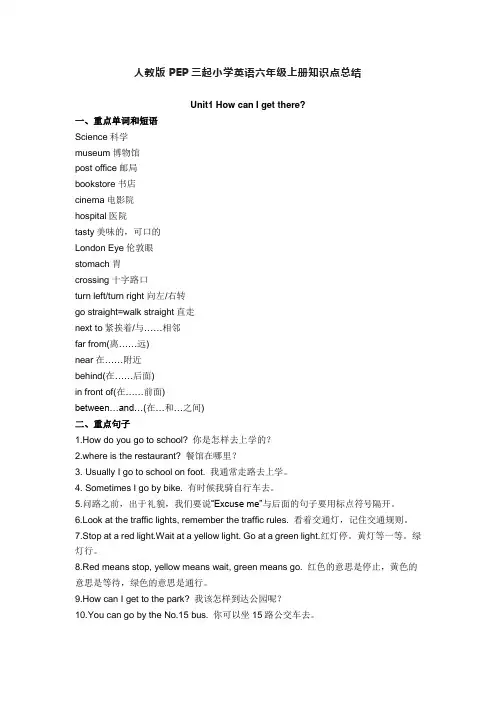
人教版PEP三起小学英语六年级上册知识点总结Unit1 How can I get there?一、重点单词和短语Science科学museum博物馆post office邮局bookstore书店cinema电影院hospital医院tasty美味的,可口的London Eye伦敦眼stomach胃crossing十字路口turn left/turn right向左/右转go straight=walk straight直走next to紧挨着/与……相邻far from(离……远)near在……附近behind(在……后面)in front of(在……前面)between…and…(在…和…之间)二、重点句子1.How do you go to school? 你是怎样去上学的?2.where is the restaurant? 餐馆在哪里?3. Usually I go to school on foot. 我通常走路去上学。
4. Sometimes I go by bike. 有时候我骑自行车去。
5.问路之前,出于礼貌,我们要说“Excuse me”与后面的句子要用标点符号隔开。
6.Look at the traffic lights, remember the traffic rules. 看着交通灯,记住交通规则。
7.Stop at a red light.Wait at a yellow light. Go at a green light.红灯停。
黄灯等一等。
绿灯行。
8.Red means stop, yellow means wait, green means go. 红色的意思是停止,黄色的意思是等待,绿色的意思是通行。
9.How can I get to the park? 我该怎样到达公园呢?10.You can go by the No.15 bus. 你可以坐15路公交车去。
pep人教版六年级上册英语各单元知识点
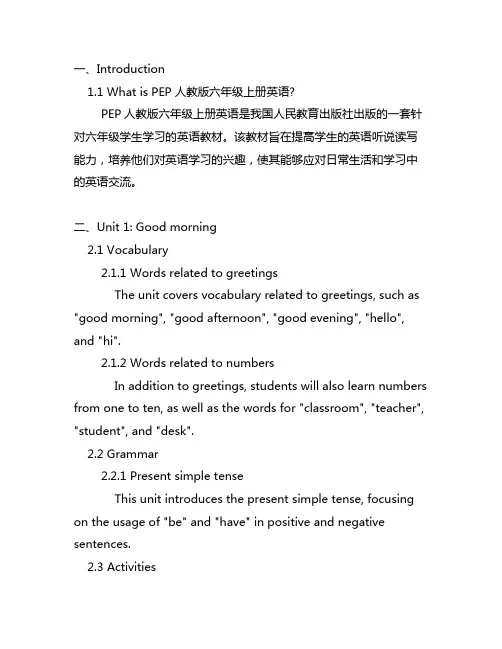
一、Introduction1.1 What is PEP人教版六年级上册英语?PEP人教版六年级上册英语是我国人民教育出版社出版的一套针对六年级学生学习的英语教材。
该教材旨在提高学生的英语听说读写能力,培养他们对英语学习的兴趣,使其能够应对日常生活和学习中的英语交流。
二、Unit 1: Good morning2.1 Vocabulary2.1.1 Words related to greetingsThe unit covers vocabulary related to greetings, such as "good morning", "good afternoon", "good evening", "hello", and "hi".2.1.2 Words related to numbersIn addition to greetings, students will also learn numbers from one to ten, as well as the words for "classroom", "teacher", "student", and "desk".2.2 Grammar2.2.1 Present simple tenseThis unit introduces the present simple tense, focusing on the usage of "be" and "have" in positive and negative sentences.2.3 Activities2.3.1 Role-playingTo practice the new vocabulary and grammar, students can engage in role-playing activities, where they take on the roles of greeting each other and asking basic questions in English.三、Unit 2: I can run3.1 Vocabulary3.1.1 Words related to sports and activitiesIn this unit, students will learn vocabulary related to sports and activities, including "run", "jump", "swim", "dance", "sing", "draw", and "read".3.1.2 Words related to expressing abilityAlong with sports vocabulary, students will also be introduced to words and phrases for expressing ability, such as "can" and "can't".3.2 Grammar3.2.1 Can and can'tThe grammar focus of this unit is on the usage of "can" and "can't" to express one's ability or inability to do something.四、Unit 3: At the zoo4.1 Vocabulary4.1.1 Words related to animalsThis unit covers vocabulary related to animals, such as "elephant", "panda", "tiger", "lion", "zebra", "giraffe", and "kangaroo".4.1.2 Words related to colorsStudents will also learn words for different colors, as many animals' physical characteristics are associated with specific colors.4.2 Grammar4.2.1 There is and there areThe grammar point of this unit is on the usage of "there is" and "there are" to talk about the existence of animals and objects at the zoo.4.3 Activities4.3.1 Describing animalsTo practice the new vocabulary and grammar, students can engage in activities where they describe different animals at the zoo using the words and phrases they have learned.五、Unit 4: Our classroom5.1 Vocabulary5.1.1 Words related to classroom objectsThis unit introduces vocabulary related to classroomobjects, such as "blackboard", "book", "pen", "pencil", "ruler", "desk", and "chair".5.1.2 Words related to prepositionsAlong with classroom objects, students will also learn prepositions such as "on", "in", "under", "behind", and "next to".5.2 Grammar5.2.1 Prepositions of placeThe grammar focus of this unit is on the usage of prepositions of place to describe the location of objects within the classroom.5.3 Activities5.3.1 Classroom scavenger huntTo reinforce the new vocabulary and grammar, students can participate in a classroom scavenger hunt, where they use prepositions to describe the location of different objects in the classroom.六、Unit 5: My school day6.1 Vocabulary6.1.1 Words related to school subjectsThis unit covers vocabulary related to school subjects, such as "Chinese", "math", "English", "music", "PE", "art", and puter".6.1.2 Words related to timeAlong with school subjects, students will also learn words and phrases related to time, such as "morning", "break", "lunch", "afternoon", and "evening".6.2 Grammar6.2.1 Present continuous tenseThe grammar focus of this unit is on the usage of the present continuous tense to talk about activities happening at the present moment.6.3 Activities6.3.1 Creating a daily scheduleTo practice the new vocabulary and grammar, students can create a daily schedule, using school subjects and time-related words to describe their typical school day.七、ConclusionThe PEP人教版六年级上册英语教材 covers a wide range of vocabulary, grammar, and activities that aim to provide students with a solid foundation in English language learning. By introducing topics such as greetings, sports, animals, classroom objects, and school subjects, the textbook offers students opportunities to engage in meaningful language use and develop essential language skills. With its systematicandprehensive approach to language learning, PEP人教版六年级上册英语 helps students cultivate their interest in English and facilitates their language acquisition process.。
最新人教版PEP小学英语六年级上册复习要点
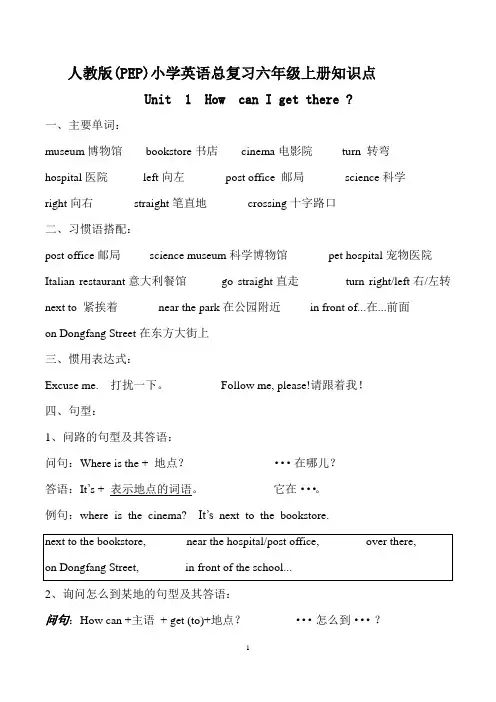
人教版(PEP)小学英语总复习六年级上册知识点Unit 1 How can I get there ?一、主要单词:museum博物馆bookstore书店cinema电影院turn 转弯hospital医院left向左post office 邮局science科学right向右straight笔直地crossing十字路口二、习惯语搭配:post office邮局science museum科学博物馆pet hospital宠物医院Italian restaurant意大利餐馆go straight直走turn right/left右/左转next to 紧挨着near the park在公园附近in front of...在...前面on Dongfang Street在东方大街上三、惯用表达式:Excuse me. 打扰一下。
Follow me, please!请跟着我!四、句型:1、问路的句型及其答语:问句:Where is the + 地点?···在哪儿?答语:It’s + 表示地点的词语。
它在···。
例句:where is the cinema? It’s next to the bookstore.next to the bookstore, near the hospital/post office, over there,on Dongfang Street, in front of the school...2、询问怎么到某地的句型及其答语:问句:How can +主语+ get (to)+地点?···怎么到···?例句:How can I get to ZhongShan park? How can I get there?同义句型:Can you tell me the way to +地点?Where is + 地点?Which is the way to +地点?答语:Turn +方向(left/right)+表示地点的介词短语。
人教版PEP 英语六年级上册 全册各单元知识点总结
Unit 1 How can I get there?一、地点词汇library 图书馆post office 邮局hospital 医院turn left 左转turn right 右转cinema 电影院bookstore 书店go straight 直行science museum科学博物馆crossing 十字路口supermarket 超市school 学校二、描述某地点所处位置的短语near 在…..附近next to 与…..相邻beside 在…..旁边in front of 在……前面behind 在…..后面between 在…..之间三、问路1.Where is the cinema, please? 请问电影院在哪儿?next to the hospital. 在医院的旁边。
in front of the school.在学校的前面.It’s behind the park .near the zoo. 在动物园的附近.far from here. 离这儿很远.2. Excuse me, is there a cinema near here.请问这附近有电影院吗?Yes, there is. /No,there isn’t.有./没有。
3. How can I/we get there? 我怎样到那儿?Turn left at the bookstore. 到书店左转4. How can I get to the hospital? 我该怎样到达医院呢?Take the No.57 bus. 乘坐第57路公汽。
By the No. 57 bus.注意:到那儿get there到某地get to Canada/Australia/Beijing/ Shanghai/Wuhanget to the hospital/zoo/bookstore四、指引路1.You can take the No.32 bus.你可乘坐312路公交车去那儿.注意:You can go by the No.32 bus.与上句意思一样,只是说法不同。
人教版(PEP)六年级英语上册期末复习知识点
人教版(PEP)六年级英语上册期末复习知识点人教版(PEP)六年级英语上册复习知识点Unit 1 How can I get there?主要单词:science科学museum博物馆post office邮局bookstore书店cinema电影院hospital医院crossing十字路口turn转弯left 向左ask问interesting有趣的Italian意大利restaurant餐馆pizza 比萨饼street大街;街道get到达GPS全球卫星定位系统feature特点follow跟着far较远的tell告诉习惯搭配turn left向左转turn right向右转go straight直行in front of...在...前面next to挨着go straight直走near the park在公园附近on Dongfang Street在东方大街上post office邮局pet hospital 宠物医院Beihai Park北海公园Italian restaurant意大利餐馆Palace Museum故宫博物院science museum科学博物馆主要句子:☆1、☆Where is the museum shop?博物馆的市肆在哪儿?☆☆2、It’s near the door.在大门附近。
☆☆3、How can we get there?我们怎么到那儿?☆☆4、Turn left at the bookstore.在书店左转。
☆5、I want to buy a postcard.我想买一张明片。
6、I’ll ask.我去问问。
7、Wow, a talking robot!哇!一个讲话机器人。
8、What a great museum!好棒的一家博物馆!10、There is a pet hospital in my city.在我的城市有一家宠物医院。
11、Wu Yifan and Robin are looking at some robots.吴一凡和罗宾正在看一些机器人。
人教版PEP六年级英语上册知识点汇总
Unit 1 How can I get there ?1. Where is the …? It’s next to/ in frontof/behind/near/beside/on the left of/on the right of the …. (询问地点和方位;记住这些方位词)2.How can I/we get there? Turn right at the school. Then go straight.How can I/we get to the sci ence museum? It’s over there. You can go by/take the No.15 bus.(问路,可以有很多灵活的回答,告知怎么走或告知交通方式,前面最好加上Excuse me。
)3. 记住以下12个疑问词:what(什么)where(哪里)who(谁)which(哪一个)how(怎么样)when (什么时候)what time(什么时间)how many(多少数量)how much(多少钱)why(为什么)whose (谁的)how old(多大)4. buy a postcard(买一张明信片)send a postcard(寄一张明信片)5. I’ll = I will6.A talking robot(一个说话的机器人)7. What a great museum! (感叹句,多么伟大/棒的一个博物馆啊!)8. There is a pet hospital in my city.There are some bookstores in my city.Is there a pet hospital in y our city?Are there any bookstores in my city?(there be句型的单复数、肯定句和一般疑问句形式回忆起来)9. What an interesting film!(感叹句,多么有趣的一部电影啊!)10. Italian restaurant (意大利餐厅)11.yum=yummy12. On Dongfang Street (注意介词)13. work 有多种意思,比如工作;奏效,起作用,需根据上下文来理解。
PEP初中英语六年级上册知识点归纳
PEP初中英语六年级上册知识点归纳一、语法篇1. Be动词:是,am,are,was,were,been。
2. 疑问词:what,where,when,why,how,who。
3. 情态动词:can,could,may,might,should,must。
4. 祈使句:动词原形。
5. 一般现在时:主语+V(原形)+其他。
6. 现在进行时:主语+be+V(ing)+其他。
7. 一般过去时:主语+V(过去式)+其他。
8. 过去进行时:主语+was/were+V(ing)+其他。
9. 将来时:主语+will/shall+V(原形)+其他。
10. 过去将来时:主语+would/should+V(原形)+其他。
二、词汇篇1. 人称代词:I,you,he,she,it,we,they。
2. 物主代词:my,your,his,her,its,our,their。
3. 形容词:big,small,long,short,tall,fat,thin,heavy,light,old,young。
4. 副词:often,seldom,always,never,sometimes,very,too,so,quite。
5. 数词:序数词(first,second,third)和基数词(one,two,three)。
6. 时间词:week,month,year,morning,afternoon,evening,night。
7. 颜色词:red,green,blue,yellow,white,black。
8. 动词:play,listen,watch,read,write,swim,dance,sing,draw,speak。
9. 名词:book,desk,chair,table,bed,door,window,picture,pen,ruler,bottle,bag,pencil case。
三、对话篇3. Talking about family: How many people are there in your family? What do your parents do?4. Talking about hobbies: Do you like…? What’s your favourite…?5. Talking about school: What subjects do you study at school? Who’s your favourite teacher?6. Talking about daily routines: What time do you get up/go to bed? What do you do on weekends?希望以上知识点归纳对您有所帮助。
- 1、下载文档前请自行甄别文档内容的完整性,平台不提供额外的编辑、内容补充、找答案等附加服务。
- 2、"仅部分预览"的文档,不可在线预览部分如存在完整性等问题,可反馈申请退款(可完整预览的文档不适用该条件!)。
- 3、如文档侵犯您的权益,请联系客服反馈,我们会尽快为您处理(人工客服工作时间:9:00-18:30)。
人教版 (PEP) 小学英语六年级上册单元知识点Unit 1 How can I get there ?一、主要单词:museum 博物馆bookstore 书店cinema 电影院turn 转弯left 向左right 向右hospital 医院post office 邮局science科学straight 笔直地crossing 十字路口二、习惯语搭配:post office 邮局science museum科学博物馆pet hospital 宠物医院Italian restaurant意大利餐馆Beihai Park 北海公园Palace Museum 故宫博物院go straight 直走turn right/left右/左转next to 挨着in front of...在...前面near the park 在公园附近on Dongfang Street 在东方大街上三、惯用表达式:Excuse me打扰一下Follow me, please!请跟着我!四、公式化句型:1、问路的句型及其答语:问句:Where is the + 地点?···在哪儿?答语:It ’s + 表示地点的词语。
它···。
next to the bookstore,near the hospital/post office,over there,on Dongfang Street,in front of the school...2、询问怎么到某地的句型及其答语:问句:How can +主语 + get (to)+地点?···怎么到···?同义句型: Can you tell me the way to +地点?Where is + 地点? Which is the way to +地点?答语:Turn +方向 +表示地点的介词短语。
···转。
at the cinema at the corner near the post office...五、例句:Where is the cinema, please?请问电影院在哪里?It ’s next to the hospital.它与医院相邻。
Turn left at the cinema, then go straight. It’s on the left. 在电影院向左转,然后直行。
它在左边。
Turn left at the bank。
在银行左转。
六、主题写作:介绍去某地的路线模板: 1、交代目的地的位置及距离The ⋯ is near/next to ⋯ It is (not) far from⋯2、说明可以采取的交通方式You can go on foot /by bus /by bike⋯3、说明路线Go straight . Turn left / right at⋯范文How to Get to the Science MuseumWe are going to the science museum tomorrow.The science museum is next to the hospital.It’s not far from our school.So we can go there on foot.First,go straight from our school.Next,turn left at the post office and walk for about five minutes.Then turn right at the bookstore.We can find the hospital on the right.Walk straight,and we’ll see the science museum.Unit 2 Ways to go to school一、主要单词: by 乘bus 公共汽车on foot 步行 plane 飞机 taxi 出租车ship(大)船subway 地铁train 火车slow 慢的stop 停下always 总是usually 通常often 经常sometimes 有时候never 从来不二、习惯语搭配:by bike/bus/plane/subway/train/ship/taxi/ferry 骑自行车 / 乘公共汽车 /飞机 /地铁 /火车 /船 /出租汽车 /渡轮take the No.57 bus乘 57 路公共汽车 on foot 步行 slow down 慢下来pay attention to 注意traffic lights 交通信号灯look right 向右看cross the road横穿马路get off 下车at home在家traffic rules 交通规则get to 到达get on 上车be far from⋯表示离某地远三、惯用表达式:Wait.等一等 .I see. 我明白了 .Go at a green light绿灯行Stop at a red light 红灯停Wait at a yellow light 黄灯等四、公式化句型:1、如何询问对方的出行方式:How do you come(to)+地点?你(们)怎么来···的?2、如何用 must 表示必须做某事:某人+must+动词原形(+其它) .···必须···。
3、告诫别人不要做某事的句型:Don’t+动词原形( +其它) ..不要 /别···。
五、例句:1. How do you go to school?你怎么去上学?ually I go to school on foot. Sometimes I go by bus.通常我步行去上学。
有时候骑自行车去。
3.How can I get to Zhongshan Park ? 我怎么到达中山公园?4.You can go by the No. 15 bus.你可以坐 15 路公共汽车去。
5.I am far from school now.我现在离学校很远。
6.My home is not far from our school.My home is near our school我.家离学校不远。
六、主题写作:介绍去上学所采用的出行方式模板: 1、说明自己家到学校的距离My home is (not) far from /near the school. 2、说明自己的出行方式I often /usually go to school⋯Sometimes I go⋯ 3、说明选择该出行方式的原因或好处It is good exercise./It is fast.范文Don’tBe Against the Traffic RulesI go to school from Mondays to Fridays. I go to school by bike at 7:30 in the morning.I have to cross two busy roads.I know the traffic rules well.Slow down and stop at a yellow light.Stop and wait at a red light.Go at a green light.I always ride on the right side of the road.I am never against the traffic rules.Unit 3 My weekend plan一、主要单词: tomorrow 明天 film 电影supermarket超市 trip 旅行 tonight 在今晚evening 晚上 /傍晚next week 下周 comic 连环画杂志dictionary 词典 word 单词post card明信片visit 拜访二、习惯搭配: take a trip 去旅行go for a picnic 去野餐go to the cinema去看电影learn to swim 学习游泳visit my grandparents看望我(外)祖父母get together 聚会go to the supermarket去超市go ice-skating 去滑冰make a snowman堆雪人 see a film 看电影make mooncakes做月饼 read a poem朗诵一首诗 this weekend这周末 Renmin Park 人民公园next week 下周 this morning/afternoon/evening 今天上午 /下午 /晚上 next Wednesday下星期三三、惯用表达式: What about you?你呢? Here they are!它们在这儿! Can I help you? 我能帮助你吗?Sounds great!听起来很棒!Have a good time!玩得开心!You too.你也是四、公式化句型:1、询问对方打算做什么的句型及其答语:问句:What are you going to do +其它?你/你们···打算做什么?next week tonight tomorrow this morning/afternoon/evening this weekend...答语:I ’m/We’re going to +动词(短语)原形+其它 .我/我们打算···。
see a film take a trip visit my grandparents watch TV...2、询问对方打算去哪儿的句型及答语:问句:Where are you going(+将来时间 )?你/你们打算(···)去哪儿?答语:I ’m/We’re going (to the)+地点 .我/我们打算去···。
3、询问对方打算何时去做某事的句型及答语:问句:When are you going to +动词(短语)原形?答语:I ’m/We’re going to +动词(短语)原形 +将来时间五、例句:.你/你们打算什么时候···?我 /我们打算···。
